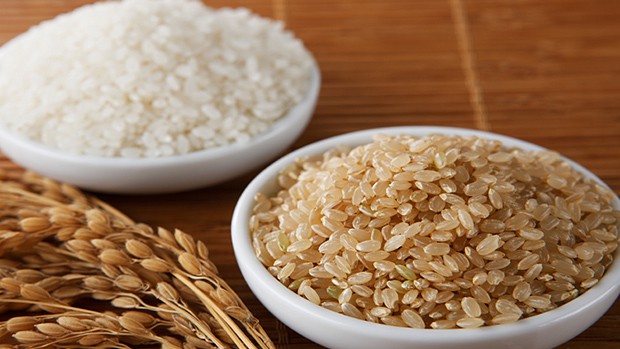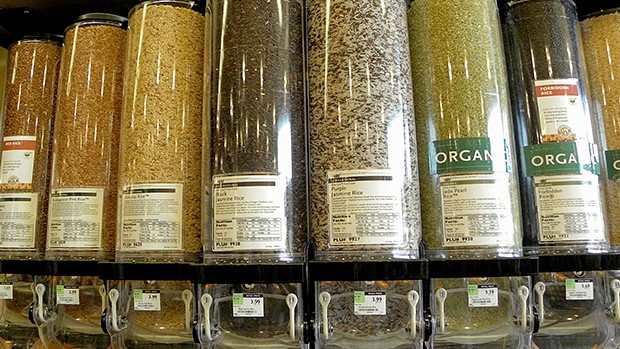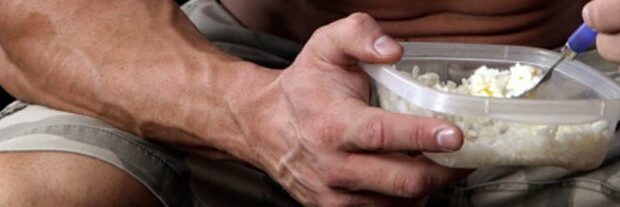The Perfect Carb for Lifters
Why White Rice is the Ultimate Grain for Athletes and Lifters
Here’s what you need to know…
-
The healthiest cultures in the world eat a starch-based diet. If you’re a lifter, you may benefit from it too.
-
White rice isn’t for the sedentary, overweight, or metabolically diseased.
-
Brown rice and other whole grains contain phytic acid, which blocks absorption of minerals and may cause digestive irritation.
-
Paleo lifters often stay “skinny-fat” because they don’t eat enough carbs to help them build muscle or train hard.
-
Overall calorie intake is crucial when it comes to fat loss. You can consume a variety of macronutrient ratios within a calorie deficit and still make progress.
The Athlete’s Whole-Food Carb
If you’re a sedentary, de-conditioned, overweight, or metabolically diseased human, white rice may be no better for you than cake.
But if you’re an anaerobic athlete or iron warrior that’s consistently leaving blood and sweat on the bar, white rice (not brown) can be a great carb source to fuel your workouts and facilitate recovery.
As a bonus, white rice doesn’t have the potential drawbacks of other sources of carbs like food allergy symptoms, GI distress, and micronutrient mal-absorption.
Carb Quality Matters
Carb quality matters as much as quantity. It matters in terms of the sustainability of a diet and its effects on digestive, metabolic, and overall health.
When you compare low carb diets to high carb diets filled with fast food, junk food, and even whole grains, of course it’s going to come out looking like the king.
But when you compare a low carb diet to carb-based diets from other cultures that eat mostly natural carb sources, the outcome is much different.
Japanese diabetes and obesity rates were never greater than 3 percent of the population pre-1991, when Western habits started to replace traditional dietary patterns.
If carbs in general are the enemy, why aren’t the Japanese the fattest, most diabetic and unhealthy population on the planet? After all, their starch intake via root vegetables and white rice is off the charts. Obviously, that’s not the case.
Condemning carbs and cutting them across the board is an irrational, uniformed approach. And I’m not just trying to get you to “turn Japanese.” The majority of the healthiest cultures in the world eat a starch-based diet.
Carb selection is key.
Rice vs. Fruity Pebbles
Consider the new study that supports this notion. Basically, one group of Asian Americans and Caucasian Americans consumed a traditional Asian diet. The other mixed group consumed a traditional Western diet.
They ate the same amount of calories, yet those who ate traditional Asian foods lost weight and improved insulin sensitivity while the Western food eaters worsened their metabolic profile.
There’s a big difference if the majority of your carbs come from Fruity Pebbles vs. fruits and roots. Whole fruit and root vegetables are better food choices to base your diet around than refined sugar and flour.
The Problem With Brown Rice: Phytic Acid
There’s a problem with brown rice and other “whole grains” that makes white rice a better choice. The problem? Phytic acid.
Despite the verdict from the court of public opinion and most dieticians, white rice is superior to brown rice and other whole grains.
Think about the goals of a lifter’s diet:
-
To provide the body with essential nutrients and micronutrients for optimum health and growth/maintenance of structural tissues, including lean muscle mass.
-
To provide the body with adequate fuel for intense training, but not so much that excessive body fat is stored (yes, calories and macro amounts matter).
-
To accomplish the first two while limiting exposure to food sensitivities and/or a high amount of “anti-nutrients” in the diet, which can lead to negative side effects.
Brown rice is like most other whole grains in that it contains an anti-nutrient called phytic acid. According to the Weston A. Price Foundation, phytic acid grabs on to important minerals and inhibits the enzymes we need to properly digest proteins and starches.

How Brown Rice Becomes White
High amounts of phytic acid impair protein digestion, mineral absorption, and lead to general GI distress. The phytic acid that’s problematic for digestion and nutrient absorption is located in the bran of the grain.
The bran is removed in the milling process that essentially changes brown rice to white rice. It’s one of the few exceptions where food refining can actually be beneficial for human health.
When you remove the bran, what you’re left with is an easily-digested “safe starch” without the anti-nutrient component. This is why white rice can be one of the best carbohydrate sources for athletes.
Additionally, white rice doesn’t cause stomach distress, allergies, bloating, and other side effects associated with so many other carbohydrate sources.
Don’t let this make you scared of your food. A bowl of brown rice isn’t going to make your bowels pop out. But, if rice is a dietary staple, like it is for me (4-7 cups per day), consider having white rice instead.
Problems can arise when brown rice and other whole grains are your main source of calories, and when you’re consuming too few animal and plant foods.
And if you’re suffering from any food intolerance, sensitivity, or GI distress symptoms despite healthy eating, why not test and assess whole grains and give white rice a shot? Why keep foods in your diet that are problematic when there are better options?
Why Nutritionists Push Brown Rice

Nutritionists and Whole Foods-hippies will still insist you eat brown rice, citing its protein and fiber content, along with the glycemic index. Don’t buy it, especially if you’re an athlete or lifter. Here’s why:
-
Protein Content: Protein from grains are less bioavailable (usable/absorbable) than animal proteins. You should be getting the bulk of your protein needs from animal sources. Any protein in grain foods is incidental, not necessary.
-
Fiber: Fiber is valuable. But you’re better off getting it mostly from natural, nutrient-dense plant sources – fruits, root vegetables, and other veggies.
-
Glycemic Index: This is probably the most misunderstood reason that people push brown rice. There’s a huge difference between short-term rises in glucose and insulin and chronically elevated levels.
Insulin fluctuations are a normal response to eating any food (even protein raises insulin levels).
Chronic elevations definitely can be problematic, and can lead to a host of diseases including insulin resistance, diabetes, obesity, and Man Boob & Muffin Top Syndrome.
But short-term (acute) elevations under certain physiological conditions can be highly beneficial to the athlete. Insulin can be anti-catabolic and anabolic. It helps transport amino acids and glucose into the muscle cell, aiding in the recovery and re-fueling process from intense training.
Carbs & Cutting
If you fear rice and starchy carbs in general, just remember that total calories are still the most important step for fat loss.
If you strength train while maintaining a relative calorie deficit, you can still include some starchy carbs in the diet while losing significant amounts of body fat.
The majority of the leanest people on Earth diet this way: natural bodybuilders and fitness models – even the non-juiced up, non-crazy, non-OCD, perfectly healthy ones.
Pre-contest diets include animal proteins for essential nutrients along with some starch to support anaerobic training. Meals like steak and sweet potato and chicken and white rice have been staples for decades.
You shouldn’t take everything gifted athletes do as gospel because genetics and drugs often play a factor, but you can’t completely ignore them either. The percentage of people who achieve success with this approach is more than just coincidence.
Where Paleo Athletes Go Wrong
The problem with today’s low carb era is what happens with people who follow a lower carb, higher fat, Paleo-style diet and combine it with consistent anaerobic training.
They end up suffering from poor performance, bad mood, anxiety or depression, muscle loss, stubborn fat, skinny-fat syndrome, insomnia, and lowered testosterone and/or thyroid production.
Then they decide to add some carbs like white rice back into their diet to see if it better supports the fueling and recovery demands of their training sessions, but they don’t change anything else. With the addition of carbs, they find themselves in a calorie surplus.
What happens? They gain fat.
So they attribute the fat gain solely to the carbs even though it had more to do with the extra calories. Then they condemn carbs, further increase their carb-fear, and go back to suffering through a mismatched diet.
You must keep calories the same if you want to truly test whether carbs like white rice are the bad guys or perhaps your best friends.
Remember, once you’re in a calorie deficit, a variety of macronutrient amounts and ratios can work for fat loss. Protein should stay constant to support lean muscle mass. That’s why your carb and added fat intake must be inversely related.
If you add carbs into your diet, you should remove an equal amount of dietary fat to stay within a targeted caloric deficit.

How to Eat
-
Sedentary populations. A carb-controlled diet is the best approach. Limit carbs to 100-125 grams a day and emphasize nutrient dense, high-satiety sources like vegetables, whole fruit, and root vegetables. Non-athletes should get all their carbs from nutrient-dense sources.
-
Anaerobic athletes and consistent lifters. You may need to add more carbs into a healthy baseline diet in order to properly fuel your training and facilitate recovery. A decent starting point is 1-2 grams of carbs per pound of lean body mass or target bodyweight.
-
Everyone. Meet the majority of your essential nutrient needs with animal proteins. Take care of most of your micronutrient needs with plant foods.
White rice is an awesome carb source you can add it into your diet to hit your targeted carb numbers. It’s basically pure starch without the anti-nutrients and potential food sensitivities of other carb sources.
And as always, with food choice recommendations like these, take some personal responsibility. Test and assess in the real world to find what works best for you. Forget the dogma and use common sense.
Reference
-
Hsu, et al. “Improvement of insulin sensitivity by isoenergy high carbohydrate traditional Asian diet: a randomized controlled pilot feasibility study.” PLoS One. 2014 Sep 16;9(9):e106851.

